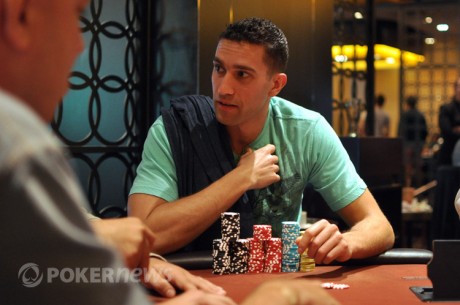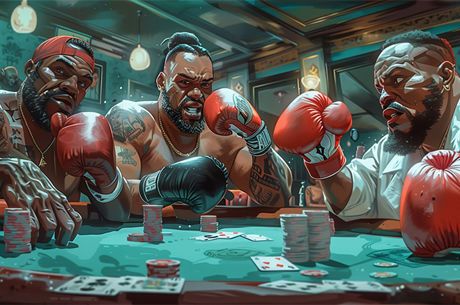Lessons from the 2014 PCA: The Importance of Position

The 2015 PokerStars Caribbean Adventure gets underway on Tuesday, January 6 with the highly anticipated $100,000 Super High Roller first on the schedule. PokerNews’ Live Reporting team will be on hand with start-to-finish coverage of that event, the $10,000 Main Event and the $25,000 High Roller. Meanwhile over the next few days we’re looking back to discuss a few key hands from last year’s PCA, each of which highlights important strategic considerations. Today we start with a hand from the final table of the 2014 edition of the $100,000 Super High Roller.
A year ago Fabian Quoss kicked off his year in triumphant fashion by winning the 2014 PCA $100,000 Super High Roller, besting a 46-entry field including Dan Shak heads-up to win the trophy and a $1,629,940 first prize. Those two battled numerous times over the course of the final table, with a hand involving the pair with four players left well illustrating how important position can be in no-limit hold’em.
Preflop
With the blinds at 40,000/80,000, Shak (pictured above) opened for a standard raise of of 175,000 — just over 2x the big blind — holding 5♠5♣. Just as standard was the defend out of the big blind by Quoss with 9♣8♣.
There’s not much to analyze here as both plays are well within accepted norms. Quoss wanted to see a flop with this hand so three-betting doesn’t make much sense as it would open up the door for Shak to four-bet which would force a fold from Quoss.
The Flop
The flop came 3♣Q♠10♣ and after Quoss checked Shak bet 225,000. Quoss called.
While both Shak and Quoss’s plays here are fine, you could make an argument for several different ways of playing the hand, especially by Quoss.
On Quoss’s end, he could have played the hand much stronger and most likely taken the pot down by doing so. Leading out with a bet probably would not accomplish that as Shak would use his position to call and then evaluate the strength of his opponent’s hand on the turn, thereby putting Quoss in a tough position. However, a check-raise would tell Shak the story that Quoss had connected with the flop. With Shak only having a pair of fives, he would have a difficult time continuing after a check-raise because he would know he’s most likely going to face a large turn bet as well.
Shak uses his position well here by betting. Quoss has shown weakness by just calling preflop and checking the flop. Shak bets just over half the pot — nothing wrong with that amount. The only other play you could make an argument for here would be to check behind, but given Quoss’s play in the hand thus far, betting is the better option.
The Turn
The turn brought the 10♠ and this time Quoss led out with a bet of 500,000 into the almost 900,000-chip pot. Shak tanked for a bit before making the call.
The problem with Quoss’s play here is that the line he took didn’t necessarily add up. If he had a Qx or 10x, he would have either bet or check-raised the flop the majority of the time. Meanwhile if he had a monster like two pair, trips, or a full house, he would most likely continue to defer to the aggressive Shak and let him make a bet that he could either check-raise or call to try to get more value on the river. Leading out, however, seems like an attempt to take down the pot.
Here is where position becomes so important. If Shak were first to act, check-calling a 500,000 bet on the turn with just a pair of fives would be very difficult because he would know he’d have to be first to act on the river and would have to check the majority of the time and react to a Quoss bet. By being in position, however, Shak gets to see how Quoss reacts to his call and can then make a river decision accordingly. Calling is a play you can make in position and one that is generally a mistake out of position.

The River
The river was the A♠, both players checked, and Shak took down the pot.
The only way Quoss could have won the pot on fifth street would have been to bet, but he elected to check. With 1.9 million in the middle and about 2.5 million behind for Quoss, checking was definitely the safest alternative. However, you could also argue that he needed to follow through with the aggressive line he took on the turn.
A bet of 800,000 would apply enough pressure to make it hard for Shak to call unless he was certain Quoss was bluffing. The difference between 1.7 million (which is what Quoss would have if he bet 800,000 and lost the hand) and 2.5 million (which is what keeps by checking) is marginal. However, the difference between 2.5 million and 4.4 million (which is what Quoss would have by winning the pot) is substantial.
Shak’s check behind was an easy decision here. If he were to bet he would usually get called by hands that beat him, plus betting would open up the door to a check-raise that he wouldn’t be able to call.
Conclusion
As illustrated above, there are many ways to play a poker hand. Position affords you the ability to process more information and make better decisions than when you are out of position. It also helps you control the pot size in many situations.
When playing poker, always try be mindful of your position and factor that into your decision as to whether to play the hand or not. If you are going to be out of position with a marginal hand, it’s usually better to err on the side of caution and fold hands you might play in other positions. When in position, however, you can widen your range because of the informational advantage you’ll have throughout the hand.
Get all the latest PokerNews updates on your social media outlets. Follow us on Twitter and find us on both Facebook and Google+!








